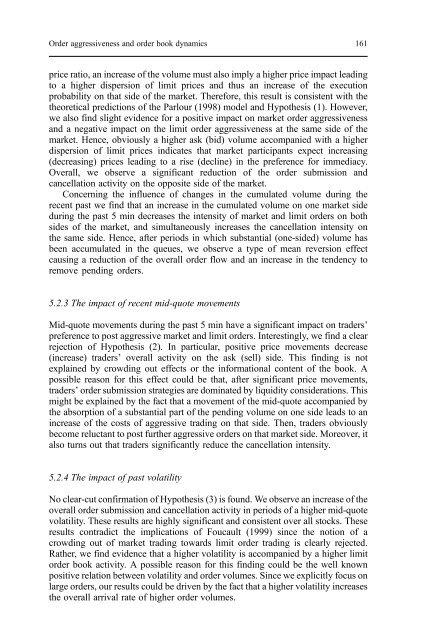recent developments in high frequency financial ... - Index of
recent developments in high frequency financial ... - Index of
recent developments in high frequency financial ... - Index of
Create successful ePaper yourself
Turn your PDF publications into a flip-book with our unique Google optimized e-Paper software.
Order aggressiveness and order book dynamics 161<br />
price ratio, an <strong>in</strong>crease <strong>of</strong> the volume must also imply a <strong>high</strong>er price impact lead<strong>in</strong>g<br />
to a <strong>high</strong>er dispersion <strong>of</strong> limit prices and thus an <strong>in</strong>crease <strong>of</strong> the execution<br />
probability on that side <strong>of</strong> the market. Therefore, this result is consistent with the<br />
theoretical predictions <strong>of</strong> the Parlour (1998) model and Hypothesis (1). However,<br />
we also f<strong>in</strong>d slight evidence for a positive impact on market order aggressiveness<br />
and a negative impact on the limit order aggressiveness at the same side <strong>of</strong> the<br />
market. Hence, obviously a <strong>high</strong>er ask (bid) volume accompanied with a <strong>high</strong>er<br />
dispersion <strong>of</strong> limit prices <strong>in</strong>dicates that market participants expect <strong>in</strong>creas<strong>in</strong>g<br />
(decreas<strong>in</strong>g) prices lead<strong>in</strong>g to a rise (decl<strong>in</strong>e) <strong>in</strong> the preference for immediacy.<br />
Overall, we observe a significant reduction <strong>of</strong> the order submission and<br />
cancellation activity on the opposite side <strong>of</strong> the market.<br />
Concern<strong>in</strong>g the <strong>in</strong>fluence <strong>of</strong> changes <strong>in</strong> the cumulated volume dur<strong>in</strong>g the<br />
<strong>recent</strong> past we f<strong>in</strong>d that an <strong>in</strong>crease <strong>in</strong> the cumulated volume on one market side<br />
dur<strong>in</strong>g the past 5 m<strong>in</strong> decreases the <strong>in</strong>tensity <strong>of</strong> market and limit orders on both<br />
sides <strong>of</strong> the market, and simultaneously <strong>in</strong>creases the cancellation <strong>in</strong>tensity on<br />
the same side. Hence, after periods <strong>in</strong> which substantial (one-sided) volume has<br />
been accumulated <strong>in</strong> the queues, we observe a type <strong>of</strong> mean reversion effect<br />
caus<strong>in</strong>g a reduction <strong>of</strong> the overall order flow and an <strong>in</strong>crease <strong>in</strong> the tendency to<br />
remove pend<strong>in</strong>g orders.<br />
5.2.3 The impact <strong>of</strong> <strong>recent</strong> mid-quote movements<br />
Mid-quote movements dur<strong>in</strong>g the past 5 m<strong>in</strong> have a significant impact on traders’<br />
preference to post aggressive market and limit orders. Interest<strong>in</strong>gly, we f<strong>in</strong>d a clear<br />
rejection <strong>of</strong> Hypothesis (2). In particular, positive price movements decrease<br />
(<strong>in</strong>crease) traders’ overall activity on the ask (sell) side. This f<strong>in</strong>d<strong>in</strong>g is not<br />
expla<strong>in</strong>ed by crowd<strong>in</strong>g out effects or the <strong>in</strong>formational content <strong>of</strong> the book. A<br />
possible reason for this effect could be that, after significant price movements,<br />
traders’ order submission strategies are dom<strong>in</strong>ated by liquidity considerations. This<br />
might be expla<strong>in</strong>ed by the fact that a movement <strong>of</strong> the mid-quote accompanied by<br />
the absorption <strong>of</strong> a substantial part <strong>of</strong> the pend<strong>in</strong>g volume on one side leads to an<br />
<strong>in</strong>crease <strong>of</strong> the costs <strong>of</strong> aggressive trad<strong>in</strong>g on that side. Then, traders obviously<br />
become reluctant to post further aggressive orders on that market side. Moreover, it<br />
also turns out that traders significantly reduce the cancellation <strong>in</strong>tensity.<br />
5.2.4 The impact <strong>of</strong> past volatility<br />
No clear-cut confirmation <strong>of</strong> Hypothesis (3) is found. We observe an <strong>in</strong>crease <strong>of</strong> the<br />
overall order submission and cancellation activity <strong>in</strong> periods <strong>of</strong> a <strong>high</strong>er mid-quote<br />
volatility. These results are <strong>high</strong>ly significant and consistent over all stocks. These<br />
results contradict the implications <strong>of</strong> Foucault (1999) s<strong>in</strong>ce the notion <strong>of</strong> a<br />
crowd<strong>in</strong>g out <strong>of</strong> market trad<strong>in</strong>g towards limit order trad<strong>in</strong>g is clearly rejected.<br />
Rather, we f<strong>in</strong>d evidence that a <strong>high</strong>er volatility is accompanied by a <strong>high</strong>er limit<br />
order book activity. A possible reason for this f<strong>in</strong>d<strong>in</strong>g could be the well known<br />
positive relation between volatility and order volumes. S<strong>in</strong>ce we explicitly focus on<br />
large orders, our results could be driven by the fact that a <strong>high</strong>er volatility <strong>in</strong>creases<br />
the overall arrival rate <strong>of</strong> <strong>high</strong>er order volumes.










